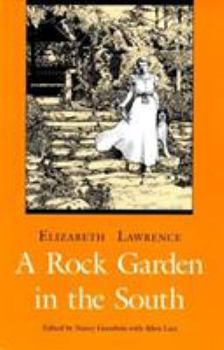A Rock Garden in the South
Select Format
Select Condition 
Book Overview
As readers and critics around the country agree, any new book by the renowned garden writer Elizabeth Lawrence is like finding a buried treasure. A Rock Garden in the South will not disappoint. Released posthumously, this book is not only a welcome addition to the Lawrence canon, but fills an important gap in the garden literature on the middle South. Lawrence, in her usual exquisite prose, deals with the full range of rock gardening topics in this work. She addresses the unique problem of cultivating rock gardens in the South, where the growing season is prolonged and humidity and heat are not conducive to such planting. She describes her own experiences in making a rock garden, with excellent advice on placing stones, constructing steps, ordering plants, and making cuttings. At the same time, what she writes about here is in large part of interest to gardeners everywhere and for gardens with or without rocks. As always, she thoroughly discusses the plants she has tried--recommending bulbs and other perennials of all sorts, annuals, and woody plants--with poetic descriptions of the plants themselves as well as specific and useful cultural advice. A Rock Garden in the South includes an encyclopedia of plants alphabetized by genus and species and divided into two parts: wood and non-woody plants.
Format:Hardcover
Language:English
ISBN:0822309866
ISBN13:9780822309864
Release Date:July 1990
Publisher:Duke University Press
Length:240 Pages
Weight:1.35 lbs.
Dimensions:0.9" x 6.4" x 9.4"
Customer Reviews
1 rating
Plant knowledge...
Published by Thriftbooks.com User , 24 years ago
In "A Rock Garden in the South" Ms. Lawrence returns to her greatest strength. I don't think anyone has ever understood rock gardens as well as Ms. Lawrence. And if you're concerned about water scarcity and drought, knowing about rock gardening is quite pragmatic. Although the book was written some time ago, and released after her death, it was edited by Nancy Goodwin and Allen Lacy, so the contents are solid and up to date. The contents read somewhat like an annotated plant list, but Ms. Lawrence writes beautiful prose so it's not at all dry and boring. In fact, her writing is useful and entertaining. Ms. Lawrence believed you could make a rock garden almost anywhere--even if you didn't have rocks. The key is to plant things that will grow in your area. Most of her writing in this book is useful for the middle South -- Zones 6-8 -- but if you look at a garden book showing the USDA growing zones you'll see they extend clear across the country. The book contains a great deal of information about plants and their likes and dislikes. There are no photographs, this is solid text, however, if I want to know what something looks like I find a catalog from Wayside Gardens and poke around. Some of the more esoteric items may not be pictured in any garden catalog with photos, but sometimes it's worth the gamble to just try something on faith. Several pages showing plant requirements (will it work in dry shade?), as well as sources for seed exchanges and nurseries are located in the back of the book.







